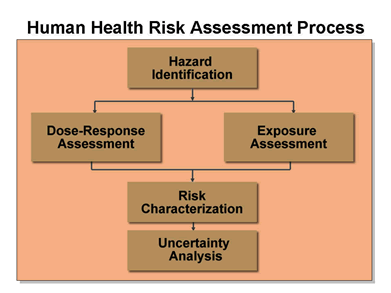Risk Assessment
Risk assessment is a tool used to evaluate the influence of a contaminant on the health of people who might come into contact with it. Risk assessments conducted under Superfund require baseline (current) and future assessments The objective of the risk assessment is to allow decisions to be made regarding clean-up of the site. The process involves:
- Hazard identification
- Dose-response assessment
- Exposure assessment
- Risk characterization and
-
Uncertainty analysis
Click on each part of the graphic to the right to learn more about each phase of the process. Use this graphic to navigate throughout this section.
|

|
Hazard identification identifies contaminated areas of a site, types of contamination present, and their concentrations. After hazard identification, levels of contaminants of concern (COCs) at the site are quantified.
Exposure assessment estimates the dose (how much) of contaminant that people coming into contact with at the contaminated site.
Dose-response assessment provides quantitative estimates of the toxicity of each contaminant of concern.
Risk characterization compares doses estimated during exposure assessment to the “acceptable” dose identified in the dose-response assessment. This comparison must be put into context by risk managers and communicated responsibly to affected communities.
The preceding steps carry uncertainties that affect the reliability of risk estimates and how they are interpreted and communicated. A risk assessment should explicitly address these uncertainties.
|